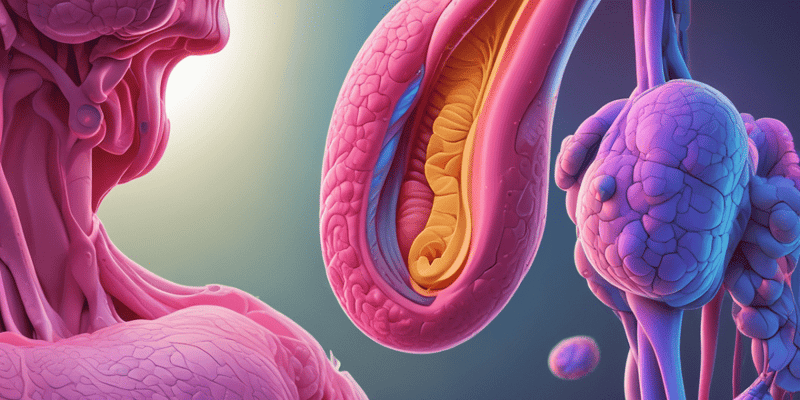Podcast
Questions and Answers
What is the primary function of the prostate in the male reproductive system?
What is the primary function of the prostate in the male reproductive system?
At what age does benign prostatic hypertrophy (BPH) commonly begin to affect men?
At what age does benign prostatic hypertrophy (BPH) commonly begin to affect men?
Which of the following statements about benign prostatic hypertrophy (BPH) is true?
Which of the following statements about benign prostatic hypertrophy (BPH) is true?
What aspect of male physiology does BPH directly impact?
What aspect of male physiology does BPH directly impact?
Signup and view all the answers
Which function is not associated with the prostate gland?
Which function is not associated with the prostate gland?
Signup and view all the answers
What is a common urinary flow rate indicative of potential urologic disorders?
What is a common urinary flow rate indicative of potential urologic disorders?
Signup and view all the answers
Which of the following tests helps assess bladder emptying integrity?
Which of the following tests helps assess bladder emptying integrity?
Signup and view all the answers
What post-voiding residual (PVR) volume is indicative of possible urologic issues?
What post-voiding residual (PVR) volume is indicative of possible urologic issues?
Signup and view all the answers
An enlarged prostate is defined as being greater than what weight in grams?
An enlarged prostate is defined as being greater than what weight in grams?
Signup and view all the answers
Which condition can cause decreased urinary flow rate similar to that seen in BPH?
Which condition can cause decreased urinary flow rate similar to that seen in BPH?
Signup and view all the answers
What procedure is performed to document the presence of prostate cancer?
What procedure is performed to document the presence of prostate cancer?
Signup and view all the answers
Which imaging technique evaluates prostate size and determines the best surgical approach?
Which imaging technique evaluates prostate size and determines the best surgical approach?
Signup and view all the answers
What finding can indicate a need for further intervention in a patient with an enlarged prostate?
What finding can indicate a need for further intervention in a patient with an enlarged prostate?
Signup and view all the answers
What does transurethral cystoscopy primarily visualize?
What does transurethral cystoscopy primarily visualize?
Signup and view all the answers
In the context of prostate examinations, what is the purpose of a transrectal prostate needle biopsy?
In the context of prostate examinations, what is the purpose of a transrectal prostate needle biopsy?
Signup and view all the answers
Study Notes
Benign Prostatic Hypertrophy (BPH)
- BPH is the most common benign neoplasm in men aged 40 years or older.
- It affects the prostate gland, which surrounds the urethra at the base of the bladder.
- The prostate produces secretions that are part of the ejaculate.
- BPH causes lower urinary tract symptoms (LUTS), which are a collection of obstructive and irritative voiding symptoms.
Epidemiology and Etiology
- BPH presents as benign prostatic hyperplasia, a histological disease common in elderly men.
- Prevalence increases with age.
- About 50% of patients with the histological disease develop an enlarged prostate on digital palpation.
- 25% of patients experience clinical voiding symptoms.
- Two major etiological factors are advanced age and androgen stimulation.
- The adult male prostate is approximately 15-20g prior to age 40.
- The testes produce 90% and the adrenal glands 10% of circulating testosterone.
- Testosterone enters prostate cells, where 5α-reductase converts it to dihydrotestosterone (DHT).
- DHT binds to a cytoplasmic receptor, causing changes in protein synthesis that promote prostate growth.
- 5α-reductase inhibitors (e.g., finasteride, dutasteride) decrease DHT production.
Prostate Tissue Types
- The prostate consists of glandular (epithelial) and muscle (stromal) tissue.
- Glandular tissue produces prostate-specific antigen (PSA).
- Muscle tissue contracts around the urethra and bladder outlet, which can be stimulated by androgens.
- Stromal tissue growth can be stimulated indirectly by estrogen, as testosterone converts to estrogen in peripheral tissues.
Pathophysiology
- BPH causes LUTS due to static and dynamic factors.
- Static obstruction involves enlargement of the prostate gland compressing the bladder neck.
- Dynamic mechanisms include increased stimulation of α1-adrenergic receptors in the prostate, urethra, and bladder neck, causing smooth muscle contraction.
- Detrusor muscle hypertrophy occurs in response to prolonged obstruction, making the bladder irritable and causing storage symptoms (e.g., urinary frequency, nocturia, urgency, incontinence).
Treatment
- The goal of treatment is to reduce or eliminate obstructive and irritative LUTS, slow disease progression, preventing complications, and minimizing adverse effects.
- Treatment options include:
- Watchful waiting: Effective for mild symptoms in some cases
- Medications: α1-adrenergic antagonists, 5α-reductase inhibitors, or combinations
- Surgery: Prostatectomy for advanced cases.
Other Diagnostic Tests and Considerations
- Decreased peak and mean urinary flow rates, increased post-void residual urine, digital rectal exam (DRE), transrectal ultrasound (TRUS), and transurethral cystoscopy, are diagnostic tools
- A 6-month minimum treatment duration may be needed to determine effects of medication
- Patients may also be advised to stop smoking, lose weight, and avoid excessive intake of caffeine-containing beverages, sugar-sweetened drinks, and alcohol.
- Prostate cancer may be a consideration when assessing patients with BPH
- Consult with a medical professional for any concerns related to BPH.
Studying That Suits You
Use AI to generate personalized quizzes and flashcards to suit your learning preferences.
Related Documents
Description
This quiz covers Benign Prostatic Hypertrophy (BPH), the most common benign neoplasm in men over 40. It explores epidemiology, symptoms, and factors contributing to this condition. Test your understanding of the prostate's role and the implications of BPH on urinary health.




